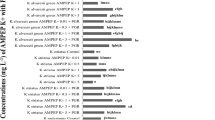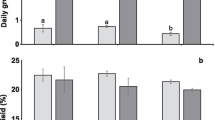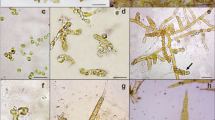Abstract
Seaweed farming has been identified as one of the entry point projects (EPPs) in Malaysia since the government introduced the Economic Transformation Programme, which aims to increase seaweed production to 150,000 t annually by 2020. To achieve this goal, micropropagation and subsequent acclimatization of the micropropagated seaweeds to the open sea is one of the available options to solve the seedling shortage problem. Acclimatization is an important process in which micropropagated seaweeds adjust to gradual changes in environments such as temperature, humidity, photoperiod, and pH. Success acclimatization is an important key for the seaweed tissue culture industry to move forward, and therefore, the protocol of acclimatization of micropropagated Kappaphycus alvarezii has been extensively optimized in this study. Direct planting out of the micropropagated seaweeds to the open sea without going through the nursery acclimatization phase may cause shock to the seaweeds due to sudden changes in environmental conditions. In a 2-week acclimatization study, seedlings were found to achieve optimum growth when cultivated in seawater enriched with mixed-algae fertilizer, natural seaweed extract (NSE), under a regimen of daily medium change and culture density of 0.40 g L−1. The acclimatized K. alvarezii has achieved 83.33 ± 5.77 % of survival in the seaweed farm with normal physiology and no epiphyte coverage. This study has provided useful information for seaweed cultivators to enhance the survival rate of micropropagated K. alvarezii through nursery acclimatization prior to serve as seedlings for commercial seaweed cultivation.





Similar content being viewed by others
References
Baweja P, Sahoo D, Garcia-Jiménez P, Robaina RR (2009) Seaweed tissue culture as applied to biotechnology: problems, achievements and prospects. Phycol Res 57:45–58
Bidwell RGS, McLachlan J, Lloyd NDH (1985) Tank cultivation of Irish moss, Chondruscrispus Stackh. Bot Mar 28:87–97
Bixler HJ, Porse H (2011) A decade of change in the seaweed hydrocolloids industry. J Appl Phycol 23:321–335
Borlongan IAG, Tibubos KR, Yunque DAT, Hurtado AQ, Critchley AT (2011) Impact of AMPEP on the growth and occurrence of epiphytic Neosiphonia infestation on two varieties of commercially cultivated Kappaphycus alvarezii grown at different depths in the Philippines. J Appl Phycol 23:615–621
Dawes CJ, Koch EW (1991) Branch, micropropagule and tissue culture of the red algae Eucheuma denticulatum and Kappaphycus alvarezii farmed in the Philippines. J Appl Phycol 3:247–257
Dunstan DI, Turner KE (1984) The acclimatization of micropropagated plants. In: Vasil I (ed.) Laboratory procedures and their applications. Elsevier Science, p 123–129
Glenn EP, Doty MS (1992) Water motion affects the growth rates of Kappaphycus alvarezii and related red seaweeds. Aquaculture 108:233–246
ETP Handbook (2012) Chapter 15: transitioning from agriculture to agribusiness. In: Economic Transformation Programme: a road map for Malaysia. Performance Management and Delivery Unit (Pemandu), Malaysia, p 513–550
Haslam SFI, Hopkins DW (1996) Physical and biological effects of kelp (seaweed) added to soil. Appl Soil Ecol 3:257–261
Hayashi L, Hurtado AQ, Msuya FE, Bleicher-Lhonneur G, Critchley AT (2010) A review of Kappaphycus farming: prospects and constraints. Cell Origin Life Extrem 15:251–283
Hurtado AQ, Critchley AT, Trespoey A, Bleicher-Lhonneur G (2006) Occurrence of Polysiphonia epiphytes in Kappaphycus farms at Calaguas Is., Camarines Norte, Philippines. J Appl Phycol 18:301–306
Hurtado AQ, Yunque DA, Tibubos K, Critchley AT (2009) Use of Acadian marine plant extract powder from Ascophyllum nodosum in tissue culture of Kappaphycus varieties. J Appl Phycol 21:633–639
Kim YH, Kim JH, Jin HJ, Lee SY (2013) Antimicrobial activity of ethanol extracts of Laminaria japonica against oral microorganisms. Anaerobe 21:34–38
Kumari R, Kaur I, Bhatnagar AK (2011) Effect of aqueous extract of Sargassum johnstonii Setchell & Gardner on growth, yield and quality of Lycopersicon esculentum Mill. J Appl Phycol 23:623–633
Kumari R, Kaur I, Bhatnagar AK (2013) Enhancing soil health and productivity of Lycopersicon esculentum Mill. using Sargassum johnstonii Setchell & Gardner as a soil conditioner and fertilizer. J Appl Phycol 25:1225–1235
Liu L, Heinrich M, Myers S, Dworjanyn SA (2012) Towards a better understanding of medicinal uses of the brown seaweed Sargassum in traditional Chinese medicine: a phytochemical and pharmacological review. J Ethnopharmacol 142:591–619
Loureiro RR, Reis RP, Critchley AT (2010) In vitro cultivation of three Kappaphycus alvarezii (Rhodophyta, Areschougiaceae) variants (green, red and brown) exposed to a commercial extract of the brown alga Ascophyllum nodosum (Fucaceae, Ochrophyta). J Appl Phycol 22:101–104
Loureiro RR, Reis RP, Berrogain FD, Critchley AT (2012) Extract powder from the brown alga Ascophyllum nodosum (Linnaeus) Le Jolis (AMPEP): a “vaccine-like” effect on Kappaphycus alvarezii (Doty) Doty ex. P.C. Silva. J Appl Phycol 24:427–432
Loureiro RR, Reis RP, Marroig RG (2014) Effect of the commercial extract of the brown alga Ascophyllum nodosum Mont. on Kappaphycus alvarezii (Doty) Doty ex P.C. Silva in situ submitted to lethal temperatures. J Appl Phycol 26:629–634
Luhan MRJ, Sollesta H (2010) Growing the reproductive cells (carpospores) of the seaweed, K. striatum, in the laboratory until outplanting in the field and maturation to tetrasporophyte. J Appl Phycol 22:579–585
Manríquez-Hernández JA (2013) Interaction of irradiance and stocking density on nutrient uptake by red macroalgae. Implications for bioremediation of fish farm effluents. M. Sc. Thesis. Dalhousie University
McHugh DJ (2003). A guide to the seaweed industry. FAO Fisheries Technical Paper 441
Mendoza WG, Montano NE, Ganzon-Fortes ET, Villanueva RD (2002) Chemical and gelling profile of ice-ice infected carrageenan from Kappaphycus striatum (Schmitz) Doty “Sacol” strain (Solieriaceae, Gigartinales, Rhodophyta). J Appl Phycol 14:409–418
Peng Z, Liu M, Fang Z, Zhang Q (2012) In vitro antioxidant effects and cytotoxicity of polysaccharides extracted from Laminaria japonica. Int J Biol Macromol 50:1254–1259
Phang SM (2006) Seaweed resources in Malaysia: current status and future prospects. Aquat Ecosyst Heal Manag 9:185–202
Reddy CRK, Jha B, Fujita Y, Ohno M (2008) Seaweed micropropagation techniques and their potentials: an overview. J Appl Phycol 20:609–617
Sade A, Ali I, Mohd Ariff MR (2006) The seaweed industry in Sabah, East Malaysia. J SE Asian Stud 11:97–107
Saha S, Navid MH, Bandyopadhyay SS, Schnitzler P, Ray B (2012) Sulfated polysaccharides from Laminaria angustata: structural features and in vitro antiviral activities. Carbohydr Polym 87:123–130
Stephenson WA (1968) Seaweed in agriculture and horticulture. Faber and Faber, London
Thorsen MK, Woodward S, McKenzie BM (2010) Kelp (Laminaria digitata) increases germination and affects rooting and plant vigour in crops and native plants from an arable grassland in the Outer Hebrides, Scotland. J Coast Conserv 14:239–247
Vairappan CS (2006) Seasonal occurrences of epiphytic algae on the commercially cultivated red alga Kappaphycus alvarezii (Solieriaceae, Gigartinales, Rhodophyta). J Appl Phycol 18:611–617
Vairappan CS, Chung CS, Hurtado AQ, Soya FE, Bleicher-Lhonneur G, Critchley A (2008) Distribution and symptoms of epiphyte infection in major carrageenophyte-producing farms. J Appl Phycol 20:477–483
Wang J, Zhang Q, Zhang Z, Song H, Li P (2010) Potential antioxidant and anticoagulant capacity of low molecular weight fucoidan fractions extracted from Laminaria japonica. Int J Biol Macromol 46:6–12
Williams A, Feagin R (2010) Sargassum as a natural solution to enhance dune plant growth. Environ Manag 46:738–747
Yabur R, Bashan Y, Hernandez-Carmona G (2007) Alginate from the macroalgae Sargassum sinicola as a novel source for microbial immobilization material in wastewater treatment and plant growth promotion. J Appl Phycol 19:43–53
Yassir SM (2012) Algae farming via mini estate system in Sabah. In Proc. of Bio-Borneo 2012. 24th–26th February 2012. Kuching, Sarawak
Yong WTL, Ting SH, Chin WL, Rodrigues KF, Anton A (2011) In vitro micropropagation of Eucheuma seaweeds. Int Proc Chem Biol Environ Eng 7:58–60
Yong YS, Yong WTL, Anton A (2013) Analysis of formulae for determination of seaweed growth rate. J Appl Phycol 25:1831–1834
Yong WTL, Ting SH, Yong YS, Thien VY, Wong SH, Chin WL, Rodrigues KF, Anton A (2014) Optimization of culture conditions for the direct regeneration of Kappaphycus alvarezii (Rhodophyta, Solieriaceae). J Appl Phycol. doi:10.1007/s10811-013-0191-4
Acknowledgments
The authors wish to thank the PEMANDU, Malaysia, for funding the research under the Seaweed Research Grant of Project EPP3 (GPRL/SPS/2), and Gofar Agro Specialties for their sponsorship in the form of enrichment fertilizers.
Author information
Authors and Affiliations
Corresponding author
Rights and permissions
About this article
Cite this article
Yong, Y.S., Yong, W.T.L., Thien, V.Y. et al. Acclimatization of micropropagated Kappaphycus alvarezii (Doty) Doty ex Silva (Rhodophyta, Solieriaceae) in outdoor nursery system. J Appl Phycol 27, 413–419 (2015). https://doi.org/10.1007/s10811-014-0289-3
Received:
Revised:
Accepted:
Published:
Issue Date:
DOI: https://doi.org/10.1007/s10811-014-0289-3




